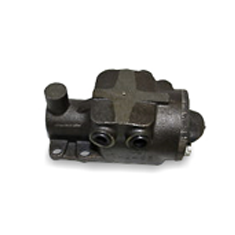
1-800-210-8170
MON-SAT 6AM-5PM PST,9AM-8PM EST24/7 ONLINE






We distribute an extensive selection of FORKLIFT STEERING VALVE parts for all makes and models. We ship directly from various warehouses located all over North America to provide the fastest shipping at the most affordable prices.
Forklift Steering Valves are components of power steering systems. Two types of power steering systems are hydraulic and electric power steering, where hydraulic is the more common of the two. Forklift power steering gear has two chambers next to a sealed piston, which is connected to the rack. The steering is made when the fluid returns from the reservoir from the application of pressurized hydraulic fluids.
Hydraulic power steering consists of the following parts: Hydraulic Control Valve; Pinion Gear; Hydraulic Pressure/Return Lines; Hydraulic Piston; and Rack Housing. Hydraulic control valve (Forklift Steering Valve) sits just above the pinion gear. It translates the steering force applied from the operator into torsional force and hydraulic pressure. As the torsion bar is rotated, the spool bar is rotated, relative to the outside. The amount of spool bar rotation between the inner and outer parts relies on the amount of torsional force applied by the operator on the steering wheel. When zero torsional force is applied on the steering wheel, hydraulic lines on both sides would have equal amount of pressure. Whereas, depending on the turning of the spool valve, either one of the hydraulic lines would have varying high pressure fluids.
The most frequently occurring problems with the power steering is fluid leaks or a broken belt. Over extensive use, the fluid hose can burst or the drive belt may fail. If the steering feels heavy or does not work, it indicates a problem with a leak. Frequently, the leaking may occur in joint areas such as where the forklift steering valve meets the hydraulic lines. Steering valves are comprised of three pieces of sealing. All three of them must have oil sealing fitted into them to ensure a solid seal.
Forklift steering valves do not fail easily and when they do fail, they are easy to replace. For a typical steering valve, all hoses and hardware has to be removed with a tubing wrench first. Then, the steering, spacers, bullstud dust shield and clamp, valve seal bushings, and valve spools are taken out. Afterwards, the valve spool is disassembled to expose the reaction valve plugs. Next step is to clean all of the components of any guck and debris and check for any corrosion or damage. Upon cleaning all parts and washing the reaction valve spring plugs, install new rubber O-rings onto the plugs. Then, reassemble all components back together. The valve should be completed sealed, sealing any fluid leaks altogether.
If the valves are corroded or broken, beyond repair, it should be replaced immediately. Solid Lift Parts Inc. specializes in identifying the exact valve required for your specific forklift model. Contact your forklift specialist today to find you the right part, right away!
*Manuals and parts books are not owned by Solid Lift Parts inc. and are presented for reference purpose only.